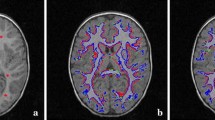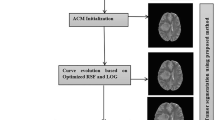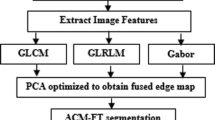Abstract
In this paper, we have proposed a new framework to use both PET and CT images simultaneously for tumor segmentation. Our method combines the strength of each imaging modality: the superior contrast of PET and the superior spatial resolution of CT. We formulate this problem as a Non-Local Active Contours (NL-AC) based-variational segmentation framework incorporating Belief Functions (BFs). The proposed method used all features issued from both modalities (CT and PET) as a descriptor to drive the NL-AC curve evolution. The new segmentation framework allows us to incorporate in the same framework heterogeneous knowledge in order to reduce the imprecision due to noise poor contrast, weak or missing boundaries of objects, inhomogeneities, etc. The proposed method was evaluated on relevant tumor segmentation problems. The results showed that our method can effectively make use of both PET and CT image information, yielding segmentation accuracy of 81.52% in Dice Similarity Coefficient (DSC) and the Average Symmetric Surface Distance (ASSD) of 1.2 ± 0.8 mm, which is 10% (resp., 16%) improvement compared to two state of art segmentation methods using the PET (resp., CT) images.
Similar content being viewed by others
References
A. Appriou, “Generic approach of the uncertainty management in multi-sensor fusion processes,” Revue Traitement du Signal 22 (2), 307–319 (2005).
U. Bagci, J. K. Udupa, N. Mendhiratta, B. Foster, Z. Xu, J. Yao, X. Chen, and J. Mollura, “Joint segmentation of anatomical and functional images: applications in quantification of lesions from pet, pet-ct, mri-pet, and mripet-ct images,” Med. Image Anal. 17 (8), 929–945 (2013).
C. Ballangan, X. Wang, and D. Feng, “Lung tumor delineation in pet-ct images based on a new segmentation energy,” in Proc. IEEE NSS/MIC (Valencia, 2011), pp. 3202–3205.
X. Bresson and T. F. Chan, “Non-local unsupervised variational image segmentation models,” UCLA Tech. Rep. (2008).
X. Bresson, S. Esedoglu, P. Vandergheynst, J. P. Thiran, and S. Osher, “Fast global minimization of the active contour/snake model,” J. Math. Imag. Vis. 28 (2), 151–167 (2007).
T. F. Chan, B. Sandberg, and L. A. Vese, “Active contours without edges for vector-valued images,” J. Visual Commun. Image Repr. 11 (2), 130–141 (2000).
D. Cremers, M. Rousson, and R. Deriche, “A review of statistical approaches to level set segmentation: integrating color, texture, motion and shape,” Int. J. Comp. Vision 72 (2), 195–215 (2007).
F. Cuzzolin, “A geometric approach to the theory of evidence,” IEEE Trans. Syst., Man, Cyber., Part C: Appl. Rev. 38 (4), 522–534 (2008).
A. P. Dempster, “Upper and lower probabilities induced by a multivalued mapping,” in Classic Works of the Dempster-Shafer Theory of Belief Functions, Studies in Fuzziness and Soft Computing, Ed. by R. R. Yager and L. Liu (2008), Vol. 219, pp. 57–72.
A. P. Dempster and W. F. Chiu, “Dempster-Shafer models for object recognition and classification,” Int. J. Intellig. Syst. 21 (3), 283–297 (2006).
F. Derraz, M. Beladgham, and M. Khelif, “Application of active contour models in medical image segmentation,” IEEE-ITCC 2, 675–681 (2004).
B. Foster, U. Bagci, A. Mansoor, Z. Xu, and D. J. Mollura, “A review on segmentation of positron emission tomography images,” Comput. Biol. Med. 50, 76–96 (2014).
T. Goldstein, X. Bresson, and S. Osher, “Geometric applications of the split Bregman method: Segmentation and surface reconstruction,” J. Sci. Comput. 45 (1–3), 272–293 (2010).
T. Goldstein and S. Osher, “The split Bregman method for l1-regularized problems,” SIAM J. Img. Sci. 2 (2), 323–343 (2009).
L. Gong, S. Pathak, A. Alessio, and P. Kinahan, “Automatic arm removal in PET and CT images for deformable registration,” Comput. Med. Imaging Graph. 30 (8), 469–477 (2006).
A. Herbulot, S. Jehan-Besson, S. Duffner, M. Barlaud, and G. Aubert, “Segmentation of vectorial image features using shape gradients and information measures,” J. Math. Imaging Vision 25 (3), 365–386 (2006).
S. Jehan-Besson, M. Barlaud, and G. Aubert, “Dream2s: deformable regions driven by an Eulerian accurate minimization method for image and video segmentation,” Int. J. Comput. Vision 53 (1), 45–70 (2003).
M. Jung, G. Peyr, and L. Cohen, “Nonlocal active contours,” SIAM J. Imag. Sci. 5 (3), 1022–1054 (2012).
B. Lelandais, I. Gardin, L. Mouchard, P. Vera, and S. Ruan, “Using belief function theory to deal with uncertainties and imprecisions in image processing,” in Belief Functions: Theory and Applications, Advances in Intelligent and Soft Computing (Springer, Berlin, Heidelberg, 2012), Vol. 164, pp. 197–204.
D. Markel, H. Zaidi, and I. El Naqa, “Novel multimodality segmentation using level sets and Jensen-Renyi divergence,” Med. Phys. 40 (12), 121908 (2013).
A. Martin, “Implementing general belief function framework with a practical codification for low complexity,” CoRR abs/0807.3483 (2008).
V. Potesil, X. Huang, and X. S. Zhou, “Automated tumor de lineation using joint pet/ct information,” Proc. SPIE, Med. Imaging: Comput.-Aided Diagn. (2007), Vol. 6514.
P. Smets, “Belief functions: The disjunctive rule of combination and the generalized Bayesian theorem,” Int. J. Appr. Reas. 9 (1), 1–35 (1993).
Q. Song, J. Bai, D. Han, S. Bhatia, W. Sun, W. Rockey, J. Bayouth, J. Buatti, and X. Wu, “Optimal cosegmentation of tumor in pet-ct images with context information,” IEEE Trans. Mach. Intellig. 32 (9), 1685–1697 (2013).
J. Wang, Y. Xia, and D. Feng, “Differential evolution based variational Bayes inference for brain pet-ct image segmentation,” in Proc. Int. Conf. on Digital Image Computing Techniques and Applications (DICTA) (Noosa, 2011), pp. 330–334.
J. Wojak, E. Angelini, and I. Bloch, “Joint variational segmentation of ct-pet data for tumoral lesions,” in: Proc. EEE ISBI (Rotterdam, 2010), pp. 217–220.
Y. Xia, S. Eberl, L. Wen, M. Fulham, and D. D. Feng, “Dual-modality brain pet-ct image segmentation based on adaptive use of functional and anatomical information,” Comput. Med. Imaging Graph. 36 (1), 47–53 (2012).
Y. Xia, L. Wen, S. Eberl, M. Fulham, and D. Feng, “Segmentation of dual modality brain pet/ct images using the map-mrf model,” in Proc. 10th IEEE Workshop on Multimedia Signal Processing (Cairns, 2008), pp. 107–110.
H. Yu, C. Caldwell, K. Mah, I. Poon, J. Balogh, R. MacKenzie, N. Khaouam, and R. Tirona, “Automated radiation targeting in head-and-neck cancer using regionbased texture analysis of PET and CT images,” Int. J. Radiat. Oncol. Biol. Phys. 75 (2), 618–625 (2009).
Author information
Authors and Affiliations
Corresponding author
Additional information
This paper uses the materials of the report submitted at the 11th International Conference “Pattern Recognition and Image Analysis: New Information Technologies,” Samara, Russia, September 23–28, 2013.
The article is published in the original.
Foued Derraz was born in Tlemcen, Algeria, in 1970. He received the Ph.D. degree in Computer science, image and signal processing from Valenciennes university, France, in 2010. His current scientific interests include variational methods in image analysis, multimodal signal processing, medical image analysis, including multi-modal image registration, segmentation, computer-assisted surgery, and diffusion MRI.
Antonio Pinti was born in France, in 1965. He received his PhD in Computer Sciences and biomedical engineering from the University of Mulhouse in 1993 (France), and is also assigned to the I3MTO laboratory at the University of Orleans (France). He is currently assistant professor at the University of Valenciennes (France). His research interests include modeling, image and signal processing for biomechanics applied to sports and rehabilitation.
Laurent Peyrodie received his PhD in automation from University of Sciences and technics of Lille in 1996, France. He is currently Associate professor at department of Energy Electrical and automation of Ecole des Hautes Etudes d’Ingenieur Lille. His research focuses on biomedical signal and image processing. His current scientific interests include EEG signal filtering, epilepy seizure detection.
Miloud Bousahla was born in sidi-BelAbess, Algeria,in 1969. He received the Elect. Eng. degree from Sidi Bel Abbes University in 1993, the magister in signal and systems, and Ph.D. degree in electronics from Tlemcen University, Algeria, in 1999 and 2012 respectively. His research interests include computational electromagnetics, microwave imaging and antennas for biological and medical applications.
Hechmi Toumi was born in Tunisia, 1971. He received PhD degree from Blaise Pascal University, France. Researcher assistant at Wisconsin University and awarded professor at the University of Wales, UK. He is a Member of the Editorial boards the journal Medicine and Science in Sports and Exercise and Journal of Foot and Ankle.
Rights and permissions
About this article
Cite this article
Derraz, F., Pinti, A., Peyrodie, L. et al. Joint variational segmentation of CT/PET data using non-local active contours and belief functions. Pattern Recognit. Image Anal. 25, 407–412 (2015). https://doi.org/10.1134/S1054661815030049
Received:
Published:
Issue Date:
DOI: https://doi.org/10.1134/S1054661815030049




